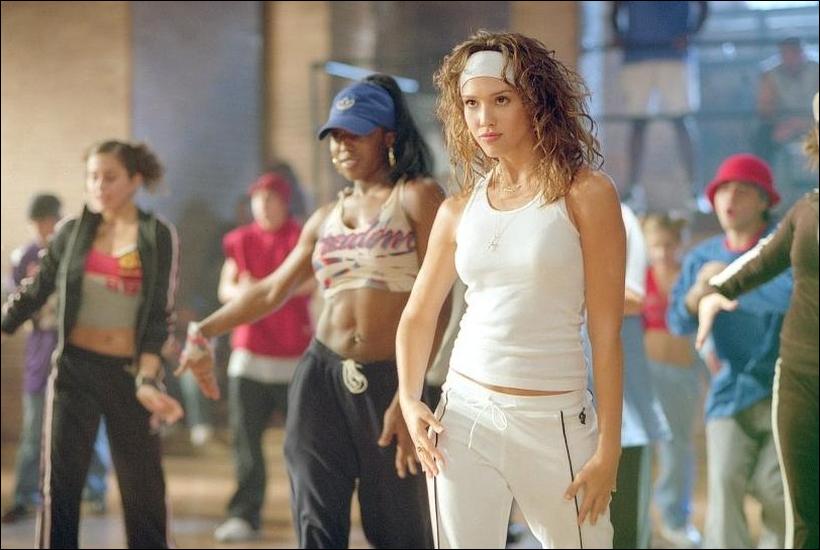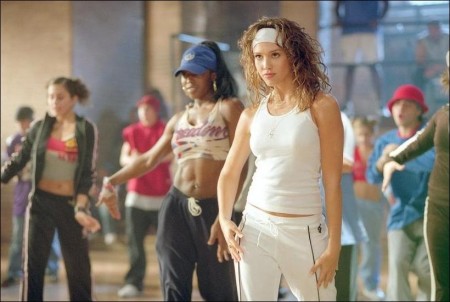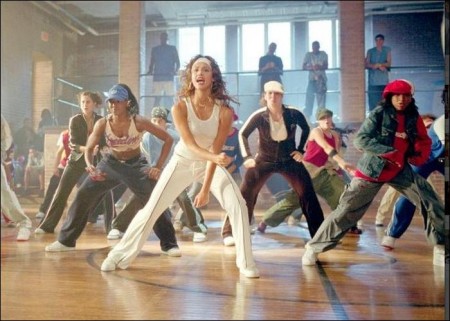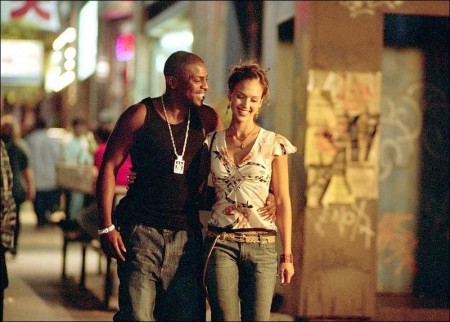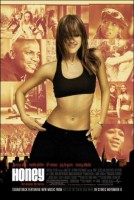Having attained success within the music industry as an initiator of some of hip-hop’s most groundbreaking and creative ventures, Andre Harrell was looking for a new challenge…and the film industry seemed a natural place to explore. Harrell knew that hip-hop culture was a treasure trove rich with characters and stories that could easily be translated to the screen. A screenplay by Alonzo Brown & Kim Watson about a dancer who wants to attain success outside of her urban neighborhood proved to have the right elements.
Harrell says, “So much of the music that I’m involved in deals with stories about finding your dreams. There’s a lot about empowerment-so many of the artists I work with are all about that. It’s about taking action, it’s about taking chances, which is exactly what I’ve always done in my career. Dreams don’t just happen, you create them. And that’s the idea that drives Honey, this kind of hip-hop rags-to-riches-to-reality story, so I was glad to roll up my sleeves and get involved with it.”
Marc Platt didn’t need much persuasion when Harrell approached him with the screenplay for Honey. Platt was already familiar with the way the genre had spread well beyond its urban origins. He had witnessed its cross-cultural popularity and was eager to become involved with the subject matter.
Platt offers, “I welcomed the great opportunity to produce this film and surround myself with the culture, the people, the music, the feel and the kids-in a way that is exciting, exhilarating and hopeful.”
With a commitment from Platt, it soon became time to find a director to bring the story to the screen, and Harrell thought of Bille Woodruff. Woodruff had established himself as a visually astute director of music videos for such artists as Britney Spears, Usher and The Backstreet Boys.
Platt wasn’t initially familiar with Woodruff’s work, but was impressed by the talent he saw. He comments, “I thought if he can evoke that kind of emotion and character in three minutes, think what he can do in the course of a full-length feature film.”
It became clear that Woodruff’s experience in directing music videos would be an asset to Honey’s urban-infused energy. “It’s a world Bille knows and since we’re exploring this world, the truthfulness, the spirit and energy of it, it’s something he can intuit and recognize easily,” adds Platt.
Woodruff wasn’t entirely sure that, as a music video director, he wanted his first feature film to be about hip-hop, but he soon saw the potential of the project. Honey was a chance to draw on his considerable knowledge about the world in which the film unfolds, while being able to showcase some of his more nascent skills.
Woodruff approached the script with the eye of an expert and remembers, “We talked about ways to keep it realistic, given my background in the world of music videos, hip-hop and rock. So we included some things that can happen, given the real world that comes into Honey’s story.”
Honey’s theme of overcoming adversity to make your dreams come true struck a deep chord in Woodruff; it took him back to his own childhood dreams. He offers, “The script appealed to me because I’d seen movies like Saturday Night Fever, Fame, Flashdance, Mahogany and Breakin’-they all spoke to me in a certain way. When I was a kid, I wanted to be a famous dancer, or a singer, or a rock star.”
The director also responded to the story’s inspirational quality and continues, “The idea of Honey’s journey got me excited. People often see these kind of stories and relate them to their own lives and the goals they would like to achieve. It would be a dream of mine to inspire a dream in a kid who sees this picture.”
Finding an actress with the right balance of emotion, sensibility, spirit and physicality to fill the role of Honey proved to be key for the filmmakers, who combed the music video and acting worlds to find their star.
Woodruff remembers it being a very grueling process in which the filmmakers and the studio explored several possibilities of how the film could be cast. He explains, “I’m very happy with the cast we found for the picture. I learned a lot through the casting process, especially that it’s very difficult because there are so many good actors and actresses. Sometimes you have to look for such a subtle quality that you really just can’t define.”
When Jessica Alba appeared in Marc Platt’s office, it suddenly became very clear that Honey Daniels had arrived. “There was something about Jessica that embodied that spirit, drive and determination of our title character,” says producer Platt.
Woodruff agrees, “It’s obvious to anyone who meets her that Jessica is a very strong person, very opinionated and very direct. I knew that she had the strength and the stamina to pull this off. I felt she could draw you into the story and take you along on her journey. I was aware of her work from Dark Angel and her beautiful, beautiful face, as well as her L’Oreal commercial. She just walked in and I liked her and she liked me. We had the same concerns about the character, we had the same notes and the same things that we wanted to bring out in Honey. So it just worked.”
Alba was also inspired by films she saw in her childhood and particularly remembers watching Flashdance as a child. She explains, “I’ve been waiting for a story like that. So Honey is a dream come true for me. This is a story people can identify with. The character of Honey is real and smart-she realizes her real love and passion is sharing the dance with the kids in her urban neighborhood. These kids could fall into gang-banging or into drugs and she provides them with a positive outlet.”
Though a naturally athletic person, Alba had never before taken dance lessons. Choreographer Laurieann Gibson had limited time to get the actress prepared to execute Honey’s smooth moves. Platt describes Alba as being up for the challenge and offers, “She worked for months in aerobics class, exercise class, workouts, and then lots and lots of dance training. She’s able to inhabit the character of Honey. The dance becomes second nature to her and the movement is an expression of who she is.”
For the role of her supportive boyfriend Chaz, Alba suggested Mekhi Phifer. “Mekhi is amazing. I felt he was the only person who could play Chaz. His presence and his heart just glow through,” Alba says.
Platt concurs, “When you watch Mekhi, you’re riveted. There’s something striking about his good looks, his performance, and his affability-which just comes through in the course of this film. The chemistry between him and Jessica is real and he makes Chaz a real, warm character.”
Woodruff recalls, “Mekhi met with Jessica and me first and we were both thinking, `I hope he likes us.’ Fortunately, he did. His thoughts about Chaz reflected the same types of thoughts that I had been having, and he was a great choice for this character with a great heart.”
The filmmakers worked to accommodate Phifer’s shooting schedule on NBC’s long-running, critically acclaimed drama, ER. Platt notes, “I was intent on having Mekhi in the film and he was intent on playing this character and luckily we both made it work.”
Chaz’s qualities appealed to Phifer because “he’s a motivator, a support structure for Honey. He’s successful at what he does and he doesn’t have to worry with trying to find himself.” Honey was also a welcome departure from the film work the young actor had previously done. “This is one of the first movies I’ve done,” smiles Phifer, “that I can bring my son, my grandparents and everyone I know to see.”
The producers also wanted to involve some up-and-coming talents in Honey. “I was working on a project with Lil’ Romeo’s father, Master P, when I first met him,” explains Platt. “As Honey started to evolve, it just came into my head-Lil’ Romeo is Benny.”
Woodruff is also effusive in his praise of the young star. “Lil’ Romeo is a superstar with a million-dollar face. He takes it very seriously by studying his lines and always being prepared. And he takes direction perfectly. The subtlest little thing that I ask him to do with his eyes at the end of the scene to convey a certain emotion-he nailed it every single time.”
“He’s a great dancer, but he has a real bad attitude,” says 14-year-old Lil’ Romeo of his character Benny. “He has bad influences like B.B. and Otis. Honey is the good influence. He wants to be on the good side, but his street friends keep pulling him back.”
Filming Honey did not keep Lil’ Romeo from his studies. “I always have to go to school, even on the set. I have to do schoolwork for about four hours a day. When I’m not shooting, I do it for five hours. If I didn’t have my education, I would not be doing this,” he explains.
Recently seen in Denzel Washington’s critically acclaimed feature directorial debut Antwone Fisher, Joy Bryant appears as Honey’s best friend, Gina. Bille Woodruff notes, “There is something very real about Joy-the fabulous, effervescent Joy Bryant. She has this earthiness about her, this instant likeability. She also provides some great comic relief. She seems like a girl who lives in the Bronx, and would be friends with Honey and be the spirit and drive behind her.”
The filmmakers were pleased with the chemistry between Alba and Bryant, and it was a feeling that the actors felt, too. Bryant explains, “I wanted to make sure that the friendship between them was authentic-that there was a genuine good friendship between the characters. Gina’s like an older sister to Honey. She may not know about the specifics of the music business, but she knows a lot about people and she knows a lot about men. She can recognize game when she sees it.”
Woodruff had a clear vision of the type of actor he wanted to cast in the role of Michael Ellis, the music video director who encourages and then derails Honey’s early success. “We needed someone who could be likable to a certain extent and then turn on a dime. We didn’t want the audience to automatically think he’s a jerk and see what’s coming.”
David Moscow had recently worked on a project with Marc Platt and was cast in the role. Moscow was familiar with the film’s setting, having grown up in the Bronx, gone to school in Harlem and now lives in New York City.
In describing his character Michael, Moscow says, “In Honey’s eyes, he is the man of the moment. He can take her and change her world, which he does, and then he snuffs it out just as quickly. And the crux of the film is whether she can survive that and still thrive.”
Eight-year-old Zachary Isaiah Williams secured the role of Raymond, Benny’s lonely little brother, despite his lack of expertise in a key area. Woodruff explains, “Zach is amazing. I knew instantly that I wanted him to play Raymond. But Zachary couldn’t dance and Raymond becomes a good dancer with Honey’s help. But I didn’t care, I knew he was perfect for the role. And I have to hand it to him, he ended up getting some moves.”
Casting Lonette McKee in the role of Mrs. Daniels, Honey’s disapproving mother, was a dream come true for Woodruff. Her seminal role in the film Sparkle and her embodiment of beauty has affected much of what he’s done as a music video director.
“Having Lonette McKee in this film was a personal treat for me. She’s an icon in the African-American community, so having her in my first movie is such a big deal to me. Anyone who knows me knows how much I love Sparkle, and they say, `Oh my God, you got Lonette!’” enthuses the director.
Playing the role of Honey’s mother was easy for the Tony-nominated actress, who recognized the character and her relationship with her daughter. McKee comments, “I’ve had very similar problems in my past, so I knew that Mrs. Daniel was within my reach.”
McKee acknowledges that she really does have a passion for hip-hop and adds, “My actual reasons for wanting to be involved in this project were specifically Bille Woodruff and Andre Harrell. I’ve been a fan of theirs for years and I’ve actually known Bille for years. When I heard he was doing his first film, I was more than happy to be involved. The icing on the cake was discovering it was such a clean, beautiful, youth-oriented and uplifting script.”
The major differences between shooting a music video and filming a feature quickly became apparent to Woodruff. He notes, “With a video shoot, I can be on top of everything, but on a feature film, you have to delegate and let people do their job and trust them to bring you what you need.”
He considers himself fortunate to have assembled his creative team, crediting them with helping him to realize his vision for the film He says, “I found a team of people whose work I really like. I feel very, very blessed. My director of photography, John Leonetti, is a prime example; he has done huge, large-scale action pictures. Honey appealed to him because it’s so different from the other kinds of things that he’d been doing. His excitement fueled my excitement. Every department head brought their best ideas to the project.”
Finding the Right Sound…
Grammy-winning producer Rodney Jerkins was brought aboard as executive music producer. His extensive credits include work with Jennifer Lopez, Destiny’s Child, Britney Spears, Mary J. Blige and other pop, R&B and hip-hop icons.
Woodruff explains how the music came together. “One of my dearest friends, music supervisor Paris Davis, came to my rescue. I had just met with a whole lot of great people, but I needed someone to really commit to being involved-feeling the story and being inspired by it-to give me music that really was made specifically for the film.”
“My music plays a character,” says Jerkins, “and that’s the phrase that got my attention.” Jerkins, who always wanted to get into the movie industry, continues, “When I was 19, I was asked during an interview where I wanted to go in life. I told them that once I conquer the music industry, it’s off to the movie industry. So I feel like it was destiny for me to be here.”
Before Jerkins came aboard, Woodruff was especially frustrated about the theme song. He explains, “People gave me stuff more suitable for a club. It didn’t build, it didn’t have an arc, it didn’t tell the story-there was no emotion. I never thought it would be that hard, because I gave them songs like `What a Feeling’ from Flashdance and the soundtrack from Fame. I wanted a modern version of that. It was very difficult to get people to go beyond what they’re doing. But we needed more for this film.”
Woodruff was moved to tears when he heard Jerkins’ “I Believe.” “Rodney totally delivered it. He heard me, he understood the story. I’ll never forget, he played the song and I had tears in my eyes. He really, really got it,” recalls the director.
Satisfied with “I Believe,” Woodruff pushed Jerkins for more. “One day I called him and said I needed another song. I roped him in. Now he’s done all kinds of stuff; songs with live musicians to jazz, to off-Broadway, to funky hip-hop to reggae. He’s awesome.”
Jerkins eventually created 16 songs for the film on a schedule that found him working seven days a week. He even surprised the director with the song “Honey.” Woodruff comments, “That song is a testament to Rodney’s commitment to the film. He’s been inspired by it. Quincy Jones has done so many different things with scoring films and I see Rodney as a young Quincy in that way.”
Producer Platt agrees that Rodney Jerkins was the perfect choice. “The music in this movie is a character and it tells part of the story. The feel of the music, the sensibility of it, the lyrics, all go hand-in-hand with the dance and the movement, the characters, the drama and the story. It was important to Bille and me to find someone that could give a voice to that in a very real way.”
Multiple Grammy-winning composer/producer/arranger/songwriter Mervyn Warren was later involved in the project to score the film, building on the blocks already provided by Jerkins and providing a fluid through line between the prominent musical pieces and production numbers woven into Honey’s story.
Getting Down the Moves…
There are several dance sequences throughout the film, ranging from club dance to music videos to Broadway auditions to neighborhood center hip-hop classes. Filmmakers realized that making a movie about dance would necessitate the involvement of a top choreographer. Enter Laurieann Gibson, one of the most sought after choreographers in the music industry and the driving force behind the dance moves of some of today’s top artists.
Woodruff explains, “Laurieann is not only the choreographer but serves as a reference point for the lead character. She is actually very much like Honey. She’s been on the scene and has done so much, from Broadway to Puffy’s music videos to stage performances to the MTV Music Awards. She’s a part of that world and has created things that have become part of the language in popular dance. We’re from that same world, so I knew she would be up for the challenge of doing this movie.”
Keepin’ it Real…
“Texture was the first thing that popped out in my mind,” says production designer Jasna Stefanovich. “Each movie I do requires research. I know a little bit about hip-hop, but I didn’t know enough. I bought all the hip-hop magazines. Then we went to New York and cruised hip-hop music stores. I grabbed a lot of hip-hop tapes that were produced independently and then researched the hell out of it.”
While the film was shot in Toronto, Stefanovich used the streets of New York’s Lower East Side and the Bronx as references. She wanted the urban scenes of Honey’s day-to-day life (the club where she works, on the street and the youth center where she teaches) to be in sharp contrast to the music video world in which she now finds herself.
Stefanovich observes, “Honey’s world is a world where dancers sweat and you see the sweat. They’re not like video dancers, where everybody looks fresh and made-up. There’s garbage on the street. It’s a place where some windows are washed and some unwashed. That’s the real-life texture I wanted.”
Filmmakers and the designer were emphatic about visually representing the passion of the dance, specifically the teenage passion of hip-hop, and differentiating that from the dance-for-hire world of video production. Honey’s world is shown full of color and texture, and the video world is represented with a crisper, cleaner palette.
Six music videos were shot for the film, two of them on very large sets. “When you’re drawing a concept for a music video set, you need feedback, otherwise you’re working in a vacuum,” says Stefanovich. “The great thing with Honey is that Bille comes from a music video background, so he’s very comfortable in that environment. Because he wasn’t intimidated, his encouragement made it seem effortless.”
In the first music video in the film, Stefanovich created a large geometric plexiglas shape in white with lights on all sides. “I wanted the set to be really minimalist so that it showed off the dancers,” explains Stefanovich. “I didn’t want to use much color because I wanted the skin to look great, and one of the most flattering ways to do that is to use white and light.”
One of the more challenging sets was the one for the music video shoot for the performer Tweet. “Several dancers were attached to wire cables that allow them to fly in and out of the set. You couldn’t have walls, so I put all the focus on the floor,” says Stefanovich. “When you’re looking at it from above, the entire floor lights up and the lights go in every direction as the dancers fly through the air-and then Tweet is lowered from the ceiling. It’s all about the floor.”
“Urban Fabulous” Fashions…
At her first meeting with Platt and Woodruff, costume designer Susan Matheson was asked about the look she planned to create “that every woman out there is going to want to emulate.” Matheson remembers, “So I told them that it’s all about airbrushing. It’s all about tattoos. We’ve got tattoos on the clothing and you’ll see that Jessica has Boriqua on the butt of her pants. The Virgin Mary is airbrushed on the back of her denim jacket. Beautiful roses are airbrushed down her arm that look like a tattoo was placed on her clothing. Tattoos are everywhere!”
Costume consultant and stylist O’Neal McKnight adds, “We got key accessories that make Honey urban fabulous. To define it, urban fabulous is Mary J. Blige, Eve… it’s about girls that come from the inner city and are beautiful, confident in their own skin, stylish and very cutting edge.”
To establish the look for the film, Matteson and McKnight went to dance auditions in New York and Los Angeles. “The core of the film is dancing, so we wanted the costumes to be authentic,” says Matheson. “We noted what dancers were wearing and elaborated on it, pushing things to make it more interesting for the film.”
The costume department built thousands of costumes for Alba and the 70 dancers who perform in the film. Matheson explains, “Dancers have such specific requirements because they have to be able to move. Most of Jessica’s costumes were built as well. Honey’s a free spirit, she doesn’t follow the crowd and her clothing has to reflect that.”
Costumes were hand painted, fabrics were pieced together like a collage, and pictures of Rick James and Diana Ross were printed on her t-shirts. Matheson’s hunt for the right look took her to Harlem, where she noticed that a lot of the women wore gold bamboo hoop earnings. “We found the neighborhood jeweler and had a pair made for Honey, as well as a ring that says `Honey.’ The character wears it all the time.”
Matheson knows that people sometimes put more care into the way they dress than they are willing to admit. “They care about their color palette, the color of their sneakers, the color of their shirt and how it all goes together,” comments the designer.
McKnight continues, “In the urban community, it’s all about uniform. The football jersey needs to match the sneakers, the baseball hat has got to match the jersey.” McKnight’s extensive contacts with several urban fashion companies in New York were instrumental in getting support from such labels as Phat Farm, Sean John, Rock Well and Snooze People.
On the challenges of costuming large casts, Matheson says, “On a movie like this where there are so many people and so many costumes, you have to be like a rubber band, able to bounce back very quickly.”
She specifically recalls dealing with an audition scene and reflects, “In the scene, everybody auditions with a top hat and wearing character shoes, which are high-heeled dance shoes. Bille decided to add 40 dancers. We had about 40 minutes to run around Toronto to find 40 more top hats-that had to be aged, by the way-and 40 more pairs of character shoes. Crew were going to the stores asking for the hats and shoes and the staff kept saying, `We don’t have that anymore-the people on Honey bought them all.’”
Honey
Directed by: Bille Woodruff
Starring: Jessica Alba, Lil’ Romeo, Mekhi Phifer, David Moscow, Zachary Williams, Joy Bryant, Lonette McKee and loads of cameo’s
Screenplay by: Kim Watson, Kate Lanier, Susannah Grant
Production Design by: Jasna Stefanovic
Cinematography by: John R. Leonetti
Film Editing by: Mark Helfrich, Emma E. Hickox
Costume Design by: Susan Matheson
Set Decoration by: Steven Essam
Art Direction by: Anastasia Masaro
Music by: Mervyn Warren
MPAA Rating: PG-13 for drug content, some sexual references.
Studio: Universal Pictures
Release Date: December 5, 2003
